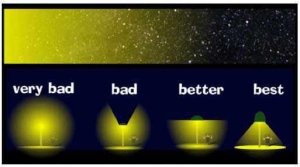
After the health of the environment and the health and safety of humans, light pollution also hits us hard in our pockets. Unused lights left on overnight, such as those in office buildings, waste energy, and for no reason. This type of illumination contributes to the general sky glow of the city as well as wasting energy. Being dark-sky friendly does not mean ‘no light,’ it means using the light that you need for a particular task in the most efficient manner possible.

Light shining into the sky creates glare and is not being used effectively. When using fully shielded lighting (i.e. downward facing light that do not emit above a 45 degree angle) you are using 100% of the energy and light output in an efficient and useful manner; you are shining light on the ground, where it is needed. This means the light on the ground will be that much brighter and you can use fewer lights at lower wattages to achieve the same illumination you got while using unshielded lighting.
An estimated 30% of street lighting is wasted light. “Wasted light” is defined as light that shines up into the sky where it does no good – or pretty much any light that doesn’t shine directly on the ground. Based on this number, it is estimated that – in the United States alone – 22,000 gigawatt-hours a year are wasted. At a conservative average of $0.10 per kilowatt-hour, the cost of that wasted energy is $2.2 billion a year – enough to annually fund a new mission to Mars. In other terms, 3.6 tons of coal or 12.9 million barrels of oil are wasted every year to produce this lost light.

This translates into an unnecessary annual release of over 15.5 million metric tons of greenhouse gases – that’s the equivalent to the amount released by seven years of electric usage from all the homes in the U.S. By simply shielding lights and lowering bulb wattage to a reasonable level, the consequences of light pollution could be easily avoided and we would save quite a bit of money that could be used for scientific research and to solve problems elsewhere.
The easy solutions to these problems are:
– Shield and lower the wattage of all outdoor lighting: Homeowners, businesses, and cities.
– Use only the light you need to get the job done.
– Use timers, dimmers, and sensors to darken unoccupied areas. Shut off the lights when you can.
– Look for IDA-approved ‘Fixture Seal of Approval’ fixtures at your local stores (Lowe’s has recently started carrying a wide variety of affordable, IDA-approved, dark-sky friendly lighting)
The fight to end light pollution begins at your front door.